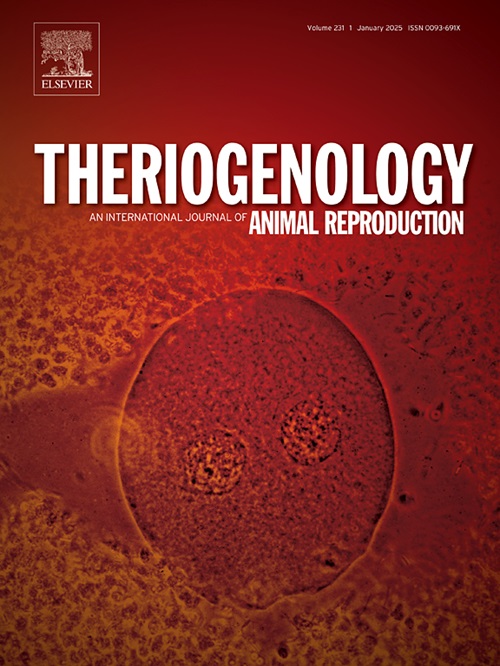Comparative proteomic and transcriptomic analysis of testicular tissue of yaks with or without cryptorchidism
IF 2.4
2区 农林科学
Q3 REPRODUCTIVE BIOLOGY
引用次数: 0
Abstract
Yak is a large plateau mammal with low reproduction rate, while cryptorchidism is a major reproductive disorder associated with infertility in highland yaks. To better understand the occurrence of cryptorchidism and its regulatory mechanisms in yaks, we conducted a multi-omic analysis, and screened a total of 4456 differentially expressed genes (DEGs) and 332 differentially expressed proteins (DEPs) between normal and unilateral cryptorchid testes of yaks using high-throughput transcriptome sequencing (RNA-seq) and Tandem Mass Tag (TMT)-based proteomics techniques, with testes from yaks with cryptorchidism as the target. Enrichment analysis revealed that the DEGs were associated with cell growth, sperm motility, immune regulation, and intercellular tight junctions, and were mainly enriched in pathways related to cell differentiation; amino acid, sugar, and lipid metabolism; cell adhesion, and hypoxia tolerance. The results of protein interactions network analyses indicated tight interactions between the differential proteins CCT2, CCT4, CCT5, FZR1, and PSMA8. In conclusion. This expression of these differential genes and proteins dysregulation may lead to the obstruction of the testicular descent process or the abnormal development of the testis, potentially leading to cryptorchidism. The results of this study laid a foundation for the screening of key candidate genes and proteins for cryptorchidism in yak, and also provided a theoretical basis for the research molecular mechanism of reproductive system diseases in yak and plateau animals.
有无隐睾牦牛睾丸组织的蛋白质组学和转录组学比较分析
牦牛是一种大型高原哺乳动物,繁殖率低,而隐睾症是高原牦牛不育的主要生殖障碍。为了更好地了解牦牛隐睾症的发生及其调控机制,本研究利用高通量转录组测序(RNA-seq)和基于串联质量标签(TMT)的蛋白质组学技术,对牦牛正常睾丸和单侧隐睾之间的差异表达基因(DEGs)和差异表达蛋白(DEPs)进行了多组学分析,筛选出4456个差异表达基因(DEGs)和332个差异表达蛋白(DEPs)。富集分析表明,deg与细胞生长、精子运动、免疫调节和细胞间紧密连接有关,主要富集于细胞分化相关通路;氨基酸、糖和脂质代谢;细胞粘附,耐缺氧。蛋白相互作用网络分析结果表明,差异蛋白CCT2、CCT4、CCT5、FZR1和PSMA8之间存在紧密的相互作用。在结论。这些差异基因和蛋白的表达失调可能导致睾丸下降过程受阻或睾丸发育异常,可能导致隐睾。本研究结果为筛选牦牛隐睾病的关键候选基因和蛋白奠定了基础,也为研究牦牛及高原动物生殖系统疾病的分子机制提供了理论依据。
本文章由计算机程序翻译,如有差异,请以英文原文为准。
求助全文
约1分钟内获得全文
求助全文
来源期刊

Theriogenology
农林科学-生殖生物学
CiteScore
5.50
自引率
14.30%
发文量
387
审稿时长
72 days
期刊介绍:
Theriogenology provides an international forum for researchers, clinicians, and industry professionals in animal reproductive biology. This acclaimed journal publishes articles on a wide range of topics in reproductive and developmental biology, of domestic mammal, avian, and aquatic species as well as wild species which are the object of veterinary care in research or conservation programs.
 求助内容:
求助内容: 应助结果提醒方式:
应助结果提醒方式:


